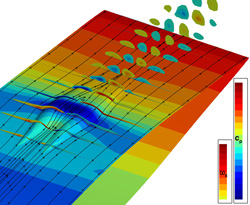New, greener wing designs
Meeting the aviation industry's ambitious targets for aircraft performance and efficiency requires new designs, to reduce drag and improve efficiency. Offering promise is the NLF wing, in spite of earlier and steeper transonic drag rise at high Mach numbers. The SCB technique may greatly reduce drag in the transonic regime, though the best ways of designing robust bumps with a broad application range up to buffet onset were unknown. The EU-funded project 'Numerical and experimental shock control on laminar wing' (NEXTWING)(opens in new window) addressed this problem. The two-member partnership aimed to provide design guidelines for SCBs under various operating conditions. They used a joint computational and experimental approach. The project ran for three years to February 2014. Team members examined drag-reduction capabilities of SCBs, the action of bumps in buffet conditions and compiled SCB design guidelines. The examination included the fundamental flow physics affecting both scenarios. Using a generic NLF wing results showed the possibility of designing SCBs that offer improvements in aerodynamic efficiency of swept wings. An improvement of 18 % was achieved at dash conditions of the considered wing cut, without affecting cruise performance. The result extends the flight envelope of a given wing design, applicable to swept wings and finite wings forming part of a full aircraft configuration. Further results revealed that, at buffet conditions, certain SCB designs delay the onset of the buffet. Yet, generally, when the flow degrades the introduction of bumps exacerbates this further. The project also identified the mechanisms by which shock bumps generate streamwise vortices. In combination with further, more detailed, findings this allows the design of shock control bumps that also generate streamwise vortices without damaging the boundary layer. Such vortices may provide additional control benefits, comparable to vortex generators. NEXTWING's results led to improved understanding of wing aerodynamics, meaning potential for improvement in efficiency and performance. Hence, the outcomes help to improve the sustainability of aviation.







